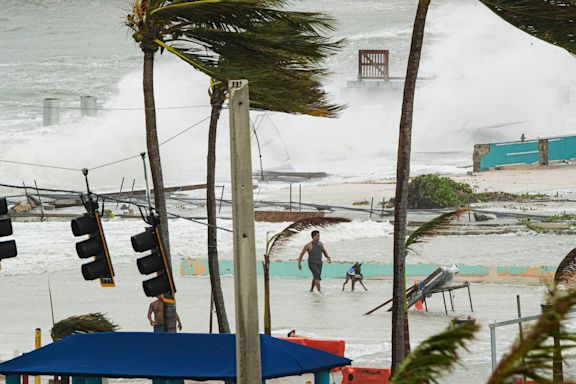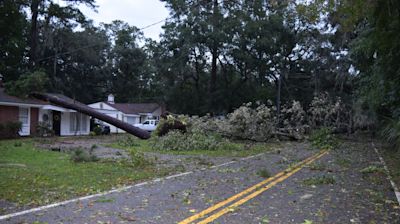Search results
74 miles
- Hurricanes are tropical storms that form in the Atlantic Ocean with wind speeds of at least 119 kilometers (74 miles) per hour.
education.nationalgeographic.org › resource › hurricane
Sep 18, 2020 · According to NOAA's Atlantic Oceanographic and Meteorological Laboratory, a hurricane's average forward speed is about 11 to 12 mph in the Gulf of Mexico, Caribbean Sea, and tropical...
People also ask
How fast does a hurricane go?
What is a 74 mph hurricane?
What are fast movers & how do they affect a hurricane?
What happens if a hurricane has a different wind speed?
Jan 6, 2019 · Now if the hurricane is moving at 10 miles an hour (16 km/hr) it will sweep over 7200 square miles (18,650 square kilometers) of ocean. That’s a lot of icebergs for just 24 hours of the cyclone’s life.
Jun 16, 2024 · When the maximum sustained winds of a tropical storm reach 74 miles per hour, it’s called a hurricane. Hurricane Season begins on June 1 and ends on November 30, but these powerful storms can occur before and after the official season.
Searches related to How many miles can a hurricane move per hour?
Oct 19, 2023 · A category 5 storm can deliver wind speeds of more than 253 kilometers (157 miles) an hour. The Atlantic Ocean’s hurricane season peaks from mid-August to late October and averages five to six hurricanes per year. While cyclones on the northern Indian Ocean typically form between April and December, with peak storm activity around May and ...
- What Are Hurricanes?
- The Coriolis Force Depends on Latitude
- Simple Understanding of Basic Forces
- Need For Outflow
- Water as Fuel
- Role of Shear
- African Dust
- What Happens in The Eye
- Storm Surge
- Location of Highest Winds
Hurricanes are tropical cyclonic storms with sustained wind speeds of at least 74 miles per hour. When determining whether the threshold has been reached to call a storm a hurricane, wind gusts are not considered. Usually, there is a progression that starts with a wave, then a depression, then a tropical storm, and finally a hurricane. A wave occur...
The Coriolis force deflects moving air to the right in the northern hemisphere and to the left in the southern hemisphere. The reason is the air moves with the Earth as it makes one rotation every twenty-four hours. So, if it moves north away from the equator, the air literally outruns the Earth, and if it moves south, the Earth outruns the air. Th...
Understanding a hurricane involves understanding a thunderstorm. Air rises. This can be caused by heating the air, making it lighter per volume. It can also be caused by two air masses coming together, whereby it is squeezed upward. Along the equator is the Intertropical Convergence Zone, where air from the northern and southern hemispheres collide...
Rising air needs a place to go. If there is no place to move the air after it has risen, there would be a blockage preventing more air from rising. This means air must be able to flow out of the top of a hurricane.
As air rises it cools due to a drop in pressure and entering a cooler environment. Cooler air cannot hold as much water in vapor form. Condensation occurs. Condensation continues to occur as air cools further due to additional rising. When water vapor liquifies it releases heat, which then warms the rising air making it more buoyant. This causes fu...
If there is shear it can cause the rising air in the thunderstorms to be blown away from the bases of the storms. This can hamper or even shut down the system.
Dust from Sahara Dessert dust storms have significance. Far out over the Atlantic the dust reflects enough sunlight to lower the temperature of the water surface. This cools the air in contact with the surface of the water. The result is the air can hold less water vapor, so there is less fuel for the system.
The spiraling air does not flow into the eye, a region of calm. The eyewall with its monstrous thunderstorms forces the spiraling air upward. The strong updrafts entrain some air from the eye, which in turn causes air from aloft to descend in the eye. This air effectively keeps the eye dry, and the weather in the eye is calm.
The intuitive idea was originally that the low pressure made the ocean act as a barometer, supporting a bulge of water in the center of a hurricane. Physics indicates reduced pressure can indeed support a slight bulge of water, but not enough to explain storm surge. Instead, the main cause of storm surge is wind sweeps waves inward toward the cente...
Wind speed in a rotating system that also is moving as a unit has two parts to consider—the tangential velocity of the rotating storm and the motion of the storm. In the northern hemisphere, the right side of a storm has tangential velocity in the same direction as the motion of the storm. Relative to the ground, the wind is the sum of the tangenti...
Jun 29, 2022 · Forecasters now believe that six to 11 (previously five to nine) of those storms could become hurricanes, meaning they would reach winds of at least 74 miles per hour.
Winds 39-73 mph: Tropical storms. Winds 74 mph or greater: Hurricanes. Major hurricanes have winds of at least 111 mph and can reach speeds of over 180 mph, with gusts of 200 mph. Hurricane Andrew: A NOAA scientist’s retrospective.









